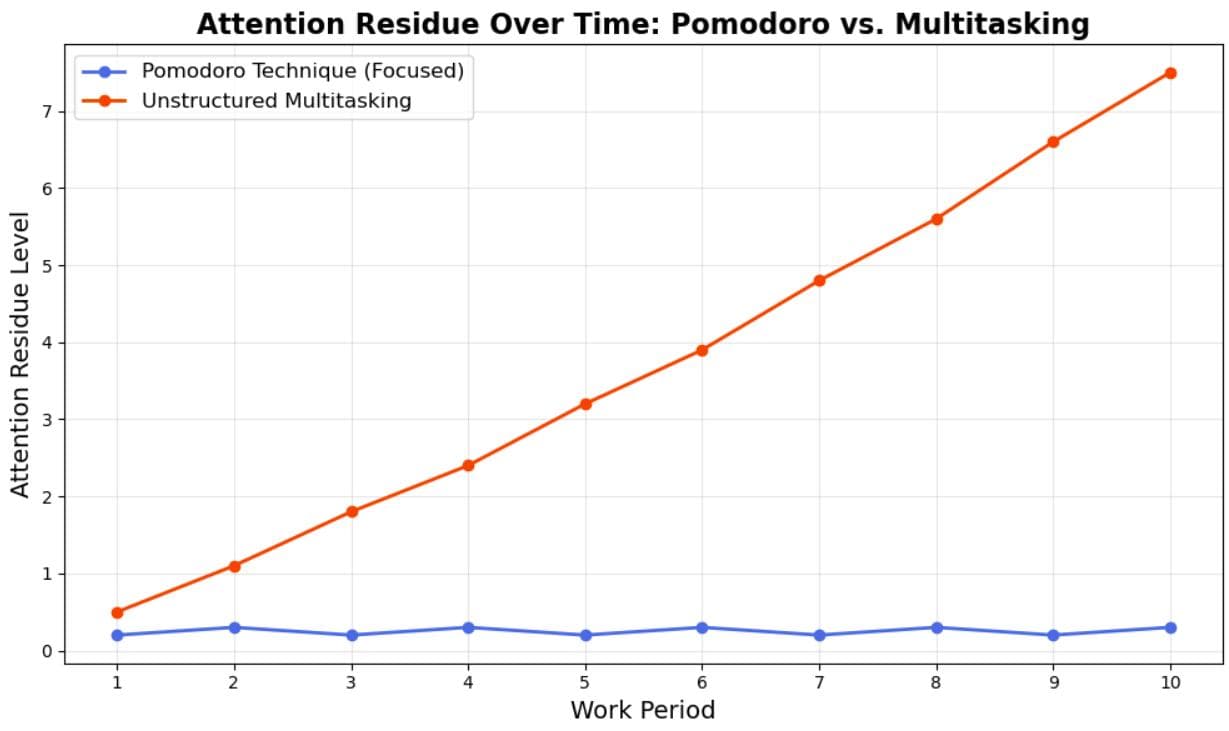What Is Attention Residue?
Attention residue is a psychological phenomenon that occurs when people switch between tasks, leaving part of their attention stuck on the previous task. Researchers have found that when we anticipate resuming interrupted work under time pressure, we find it difficult to switch our attention to new tasks, leading to decreased performance on the interrupting task.
This concept helps explain why multitasking feels so mentally exhausting. Studies show a negative link between media multitasking and sustained attention of medium effect size, whether measured through questionnaires or task-based assessments. The research reveals that our brains simply aren't designed to handle the constant cognitive switching that modern work environments demand.
The Science Behind Task Switching Costs
When we switch between tasks, our brains must undergo complex neural adjustments. Research using advanced brain imaging techniques shows functionally distinct processes occurring in different regions during task switching, with multiple overlapping operations happening simultaneously in frontoparietal cortical networks.

Click to zoom
The research shows that cognitive flexibility across different domains operates independently. When people switch between tasks like digit magnitude versus parity tasks, or shift attention between different stimulus locations, these adaptations don't transfer across domains. This means that frequent task switching actually makes us worse at both types of cognitive flexibility over time.
The Multitasking Myth Exposed
Despite popular belief, research consistently demonstrates that multitasking impairs performance. Studies involving college students found significant positive correlations between media multitasking and both anxiety and depression, with attention focusing serving as a critical mediating factor.
The research reveals that multitasking creates a cascade of negative effects. When people attempt to reorient attention between different tasks, brain-wide network dynamics become disrupted, requiring increased physiological arousal to maintain performance. This explains why multitasking feels so draining and why we often feel scattered after a day of constant task switching.
The Attention Control Connection
Research shows that media multitasking negatively affects cognitive capacity through its impact on attention control. People who frequently multitask show decreased ability to focus attention and increased bias toward negative information. This creates a vicious cycle where poor attention control leads to more multitasking, which further degrades attention control abilities.
Breaking Free from Attention Residue
The good news is that attention residue can be minimized through strategic interventions. Research shows that creating a "ready-to-resume" plan can significantly reduce attention residue effects. When people briefly reflect on and plan their return to an interrupted task, attention residue decreases and performance on the interrupting task improves.
1. Implement Strategic Breaks
Studies comparing different break-taking strategies reveal important insights about attention restoration. Research shows that taking predetermined, systematic breaks during study sessions provides mood benefits and efficiency advantages compared to self-regulated breaks. The structured approach helps maintain concentration and motivation while reducing fatigue and distractedness.
2. Use Time-Boxing Techniques
The Pomodoro Technique has gained scientific validation for its effectiveness in combating attention residue. Research demonstrates that students using the Pomodoro technique show significantly better concept mastery compared to traditional lecture methods. The technique's timed intervals help create clear cognitive boundaries that minimize attention residue between tasks.
3. Create Transition Rituals
Developing specific rituals for task transitions can help clear attention residue. Research on rest-break effectiveness shows that structured approaches to recovery can mitigate the adverse effects of increasing task demands on performance and well-being. These rituals act as cognitive reset mechanisms, helping the brain fully disengage from one task before engaging with another.
4. Optimize Your Digital Environment
Creating a distraction-free digital environment is crucial for minimizing attention residue. Digital focus tools, such as DistractShield, can help by blocking distracting websites and applications, preventing the constant micro-interruptions that create attention residue throughout your workday.
The Path to Sustained Focus
Understanding attention residue is the first step toward reclaiming your cognitive resources. Research shows that people with low levels of media multitasking benefit significantly from sustained attention practice, showing decreased distractibility and increased task performance. In contrast, high media multitaskers show inconsistent attention patterns and reduced benefits from attention training.
The key is recognizing that attention is a finite resource that requires careful management. By implementing strategies to minimize task switching, creating structured work environments, and using tools that support sustained focus, you can dramatically reduce the hidden tax of attention residue on your mental performance.
Start by auditing your current work patterns. Notice how often you switch between tasks, check notifications, or allow interruptions. Each switch carries a cost in the form of attention residue. By becoming aware of these patterns and implementing systematic changes, you can begin to experience the clarity and productivity that comes with truly focused work.